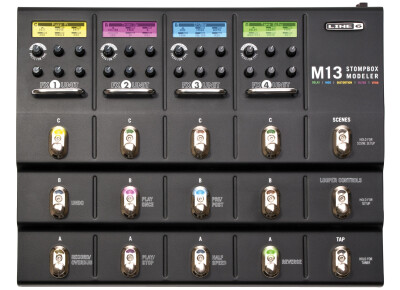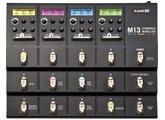Tech. sheet
- Manufacturer: Line 6
- Model: M13
- Series: Stompboxes Modeler
- Category: Multi-Effects for Electric Guitar
- Other names:m 13, m13 stompbox, m 13 stompbox, m13stompbox
We have no technical specifications for this product
but your help will be much welcomed
»
News
Videos
User reviews
4.5/5(17 reviews)
5
71 %
4
18 %
3
2
6 %
1
6 %
Line6 scores a direct hit with the M13--this is Stomp Box Heaven!!!
Published on 08/18/12 at 11:57The Line6 M13 is the flagship stomp box modeling unit from Line6. Unlike most of the Line6 products, this unit does not have all of the signature Line6 amplifier and speaker cabinet modeling software at your disposal. This unit is designed to work WITH your amp and not in place of it. Do not be fooled by this however. The M13 is an extremely flexible unit in that there are myriad different options for sound shaping including the various different stomp box models and the connection options that allow you to connect your amp via the now-famous 4-cable method. This allows you to put effects in their proper place, with distortion and non-modulation effects before your amp's preamp stage,...…
Read more
The Line6 M13 is the flagship stomp box modeling unit from Line6. Unlike most of the Line6 products, this unit does not have all of the signature Line6 amplifier and speaker cabinet modeling software at your disposal. This unit is designed to work WITH your amp and not in place of it. Do not be fooled by this however. The M13 is an extremely flexible unit in that there are myriad different options for sound shaping including the various different stomp box models and the connection options that allow you to connect your amp via the now-famous 4-cable method. This allows you to put effects in their proper place, with distortion and non-modulation effects before your amp's preamp stage, and the time-based and modulation effects after the preamp stage. The amp also has MIDI capability if you want to use it as a controller or control it via MIDI. The MIDI implementation is not the most straightforward but can be figured out with an investigation of the downloadable MIDI Implementation Guide.
UTILIZATION
The words "Bonehead Simple" are actually printed on the M13 box and I think that about says it all. I received the M13 with the updated 2.01 software on-board. The one thing you DO have to watch out for is that it could be perceived as OVERLY bonehead simple. During one of my trial sessions, I couldn't figure out why sound was coming out of my amp but nothing was happening on the M13. That's because the M13 is truly "true bypass" and it simply wasn't powered on. So you know that if your M13 dies mid-gig, your signal will still get to your amp. Excellent!!
This is a great (relatively) little unit. The beauty of the M13 lies in its simplicity and flexibility. It takes about 10 seconds to memorize the color coding for the different types of effects, but hours to go through the settings and different models. There are two different modes of operation: Standard mode and Scene mode. Scene mode works like any other MIDI patch--you call up the patch and it brings up the pre-configured models in the pre-configured order and with the pre-configured levels. In scene mode you have access to the active models in each bank and you can toggle them on and off individually.
In standard mode you have access to 12 different stomp boxes'four banks with three options in each position. The payoff is no cables and no re-wiring. When you call up a model, the stomp box is activated with the last settings already pre-programmed. There is a global option to either save all settings automatically or not. I suggest leaving it on as that is really the purpose of the M13. I haven't yet found a need to have the settings NOT automatically saved. Without the auto-save enabled, any called-up model will accept the position of the knobs as-is' most likely undesirable.
When I started writing this review, I liked working in standard mode over the Scenes, although in truth the 'Standard' mode is really just a 'scratch pad' scene. Unless you have a special need for a high number of different sounds, you can get a great deal out of standard mode. I have my 'Scratch Pad' M13 scene set up in the following configuration:
Bank 1: A. Screamer, B. Blue Comp Treble C. Line6 Drive
Bank 2: A. Line6 Distortion, B. Heavy Distortion, C. Dimension
Bank 3: A. Noise Gate, B. Dual Phaser, C. Tri-Chorus
Bank 4: A. Stereo Delay, B. Noise Gate, C. Echo
Notice that I have the Noise Gate in two different positions and weaker distortions in front of heavier distortions. This allows me to either run the Screamer or Comp for a little boost of my amp's preamp or the Bank B distortion. Having the Noise Gate in Banks 3 AND 4 allows me to either put the gate at the end of the signal if running in 2-cable mode, or after the distortion effects in 4-cable mode so that the modulation effects are super-clean. In the latter configuration, the modulation effects really shine through the mix. With this configuration, I can get punishing distortion out of the M13, juice the front end of my amp, or get wonderful multi-dimensional clean tones. After learning about the flexibility of the M13 and how to better leverage scenes, a whole new world opened up to my tonal 'mad science.'
It's like having 12 stomp boxes at your disposal at a time, 12 sets of 12 stomp boxes, and you can activate any of them in their pre-defined position' NO WIRING!!! The only thing you can't do is have more than four boxes active at any one time, one from each bank. (You can only have one 'A', one 'B', one 'C', one 'D' on at a time). Pressing the foot switch activates the effect. Pressing another button in the same bank activates that effect and deactivates the previous one. Pressing the button of the active effect toggles it on/off. There is a dedicated button to activate the looper, a button to activate Scene mode, and holding the looper button activates the on-board tuner. The tuner is one of the most sensitive I have encountered.
After running the M13 straight into the front of the amps, I configured the M13 to have the effects loop in between banks 2 and 3. This one of the other beautiful features of the M13: you can place the effects loop wherever you want as opposed to being locked into one configuration.
Line6 characteristically doesn't include a ton of literature with their products because just about all of their product information is downloadable from the web. While I appreciate their commitment to green initiatives this doesn't help much when you're at the gig and there's no internet connection and you REALLY need some help from a manual. Still, the unit is easy enough to figure out that you only need the manuals for the really intricate operations.
SOUND QUALITY
I played this modeler with the following guitars:
VOS '58 and '59 Gibson Custom Les Paul guitars with Burstbucker 1 and 2 models
Gibson Raw Power Les Paul with '57 Classic pickups
Ibanez JEM 7VSBL with stock Dimarzio Evolution pickups installed
Ibanez RG550MXXDY with Dimarzio Super 3 Bridge, Evolution Middle, and Evolution Neck
Ibanez RGR4 with Dimarzio Crunch Lab Bridge and LiquiFire Neck
Epiphone Les Paul Standard with Seymour Duncan Phat Cat P-90's
PRS SE Semi-hollow with stock pickups
Squier Telecaster with Dimarzio Air Norton T bridge and Area T Neck
B.C. Rick Mockingbird Neck-Thru with Dimarzio Super Distortion bridge and Super 2 Neck
Squier Strat with Dimarzio VV Solo bridge, VV '54 middle, and VV Heavy Blues neck.
I played the M13 through the following amps:
Marshall JVM410H head and Crate Blue VooDoo stereo 4 x 12 with Jensen 60's
Marshall HAZE 40w 1 x 12 combo
Marshall Class 5 1 x 10 combo
Marshall Vintage Modern 50-watt head and a Carvin mono 4 x 12 with Celestion Heritage 30's
Mesa Boogie 1 x 12 Mark V combo
Marshall DSL100MLB full stack.
Marshall Vintage Modern 50-watt head and a Carvin mono 4 x 12 with Celestion Heritage 30's + Hughes & Kettner TriAmp MK II and a Carvin mono 4 x 12 with Celestion Vintage 30's in stereo.
The M13 ended up sounding the best with the Marshall HAZE 40 so I used that as my basis for sound. Hooking up the M13 with the 4-cable method opened up a whole new dimension to the tone. The distortions were tighter and the clean tones were, well, cleaner since I could just run the clean (standard) channel preamp valves of the HAZE. One of my favorite models in the M13 is the model of the old BOSS Dimension C. If you tinker with the different switch combinations on the Dimension C you can get everything from light Chorus to Phase to some unique sounds. I highly recommend using this effect to add a unique ambience to your sound. The Blue Comp + Treble model is nice for cleaning up the darker overtones of the EL34 power valves and really focuses the tone when engaged. Using the Screamer model adds a nice compressed boost to just about anything after without adding too much gain. I didn't have much use for any of the 'Purple' category models, but I play pretty straight-ahead rock, so your mileage may vary. The quality of the models is so good I encourage you to at least try them. There are only a few reverb models in there, but the ones that ARE there are all I could want or need in a reverb including 100-200 millisecond echo model. You can get lost in the delays, especially in the Scene dedicated to them.
One of the things I found odd about the M13 is that the EQ models were in the preamp (yellow) category, making them somewhat hard to locate at first. Also, putting them in that category limits the number of EQ/Overdrive/Distortion combinations you can create, but I suppose they had to put them somewhere.
Even though there is a Noise Gate pedal model, there is also a master noise gate that is accessible from the main Setup screen, so if you can live with just the overall noise reduction of the M13 you can save pedal spots.
The M13 nailed everything. Usually, when you are working with a complex unit like the M13 you'll find something where you're relatively unimpressed. While there are effects in the M13 that I would probably never use, there was no effect that I tried where I thought the model simply didn't pass muster. Line6 really took the time to get all of the models right and it shows when you hit the strings. I found all of the tones easy to work with and great-sounding. You know you've got a good product on your hands when you come across an effect that you've never really been a fan of, but the implementation in the Line6 M13 wins you over.
OVERALL OPINION
So what's the verdict? It really depends on what you're after. I've read a lot of material that compares the M13 to other Multi-Effects like the BOSS GT-10 or Line6 POD X3 Live. At first, the difference seems pretty obvious... Units like the GT-10 and X3 Live have amp and cabinet models in them and have the ability to emulate both and amp and add effects, where the M13 just adds effects (no amp modeling here), so one would be led to think that the M13 needs to be run into/with an amp, whereas the others can just be run straight to the board or recording console. Well, I got to thinking about it. Let's say for example I just want to use the M13 in 2-cable mode right into the front of my, um, 1968 Plexi. No problem, right? Well, what's the difference between running the M13 into a 'real' Plexi and running the M13 into the POD Farm model of a Plexi? Turns out not very much--you have to tweak the levels a bit, but I found that I could run the M13 in front of my Line6 KB37 and then into POD Farm and with minimal adjustment of levels I got the same results as running into a 'real' amp. How cool is that? I initially figured to get the M13 recorded I would have to turn on an amp and mic a cabinet. Not so. Just wire it in front of your amp modeling software of choice, tweak it to taste and you're good to go.
My biggest issue with the M13 as noted previously is that the MIDI implementation on the M13 isn't the most straightforward or "plug-and-play" like most other units that factory default to OMNI/ON so that they just work right out of the box. If the MIDI implementation were as easy to work with as other comparable units the M13 would have scored perfectly.
Bottom line, not only is the M13 a great stomp box modeler on its own, providing you with an arsenal of stomp boxes that would cost you thousands to collect and would be a nightmare wiring up the signal chain, Line6 has done it all for you in an affordable, flexible package that works for both live performance, live recording, or in front of your DAW. If there's a sound you're looking for that you can't coax out of the M13, well, there are always drums, right?
UTILIZATION
The words "Bonehead Simple" are actually printed on the M13 box and I think that about says it all. I received the M13 with the updated 2.01 software on-board. The one thing you DO have to watch out for is that it could be perceived as OVERLY bonehead simple. During one of my trial sessions, I couldn't figure out why sound was coming out of my amp but nothing was happening on the M13. That's because the M13 is truly "true bypass" and it simply wasn't powered on. So you know that if your M13 dies mid-gig, your signal will still get to your amp. Excellent!!
This is a great (relatively) little unit. The beauty of the M13 lies in its simplicity and flexibility. It takes about 10 seconds to memorize the color coding for the different types of effects, but hours to go through the settings and different models. There are two different modes of operation: Standard mode and Scene mode. Scene mode works like any other MIDI patch--you call up the patch and it brings up the pre-configured models in the pre-configured order and with the pre-configured levels. In scene mode you have access to the active models in each bank and you can toggle them on and off individually.
In standard mode you have access to 12 different stomp boxes'four banks with three options in each position. The payoff is no cables and no re-wiring. When you call up a model, the stomp box is activated with the last settings already pre-programmed. There is a global option to either save all settings automatically or not. I suggest leaving it on as that is really the purpose of the M13. I haven't yet found a need to have the settings NOT automatically saved. Without the auto-save enabled, any called-up model will accept the position of the knobs as-is' most likely undesirable.
When I started writing this review, I liked working in standard mode over the Scenes, although in truth the 'Standard' mode is really just a 'scratch pad' scene. Unless you have a special need for a high number of different sounds, you can get a great deal out of standard mode. I have my 'Scratch Pad' M13 scene set up in the following configuration:
Bank 1: A. Screamer, B. Blue Comp Treble C. Line6 Drive
Bank 2: A. Line6 Distortion, B. Heavy Distortion, C. Dimension
Bank 3: A. Noise Gate, B. Dual Phaser, C. Tri-Chorus
Bank 4: A. Stereo Delay, B. Noise Gate, C. Echo
Notice that I have the Noise Gate in two different positions and weaker distortions in front of heavier distortions. This allows me to either run the Screamer or Comp for a little boost of my amp's preamp or the Bank B distortion. Having the Noise Gate in Banks 3 AND 4 allows me to either put the gate at the end of the signal if running in 2-cable mode, or after the distortion effects in 4-cable mode so that the modulation effects are super-clean. In the latter configuration, the modulation effects really shine through the mix. With this configuration, I can get punishing distortion out of the M13, juice the front end of my amp, or get wonderful multi-dimensional clean tones. After learning about the flexibility of the M13 and how to better leverage scenes, a whole new world opened up to my tonal 'mad science.'
It's like having 12 stomp boxes at your disposal at a time, 12 sets of 12 stomp boxes, and you can activate any of them in their pre-defined position' NO WIRING!!! The only thing you can't do is have more than four boxes active at any one time, one from each bank. (You can only have one 'A', one 'B', one 'C', one 'D' on at a time). Pressing the foot switch activates the effect. Pressing another button in the same bank activates that effect and deactivates the previous one. Pressing the button of the active effect toggles it on/off. There is a dedicated button to activate the looper, a button to activate Scene mode, and holding the looper button activates the on-board tuner. The tuner is one of the most sensitive I have encountered.
After running the M13 straight into the front of the amps, I configured the M13 to have the effects loop in between banks 2 and 3. This one of the other beautiful features of the M13: you can place the effects loop wherever you want as opposed to being locked into one configuration.
Line6 characteristically doesn't include a ton of literature with their products because just about all of their product information is downloadable from the web. While I appreciate their commitment to green initiatives this doesn't help much when you're at the gig and there's no internet connection and you REALLY need some help from a manual. Still, the unit is easy enough to figure out that you only need the manuals for the really intricate operations.
SOUND QUALITY
I played this modeler with the following guitars:
VOS '58 and '59 Gibson Custom Les Paul guitars with Burstbucker 1 and 2 models
Gibson Raw Power Les Paul with '57 Classic pickups
Ibanez JEM 7VSBL with stock Dimarzio Evolution pickups installed
Ibanez RG550MXXDY with Dimarzio Super 3 Bridge, Evolution Middle, and Evolution Neck
Ibanez RGR4 with Dimarzio Crunch Lab Bridge and LiquiFire Neck
Epiphone Les Paul Standard with Seymour Duncan Phat Cat P-90's
PRS SE Semi-hollow with stock pickups
Squier Telecaster with Dimarzio Air Norton T bridge and Area T Neck
B.C. Rick Mockingbird Neck-Thru with Dimarzio Super Distortion bridge and Super 2 Neck
Squier Strat with Dimarzio VV Solo bridge, VV '54 middle, and VV Heavy Blues neck.
I played the M13 through the following amps:
Marshall JVM410H head and Crate Blue VooDoo stereo 4 x 12 with Jensen 60's
Marshall HAZE 40w 1 x 12 combo
Marshall Class 5 1 x 10 combo
Marshall Vintage Modern 50-watt head and a Carvin mono 4 x 12 with Celestion Heritage 30's
Mesa Boogie 1 x 12 Mark V combo
Marshall DSL100MLB full stack.
Marshall Vintage Modern 50-watt head and a Carvin mono 4 x 12 with Celestion Heritage 30's + Hughes & Kettner TriAmp MK II and a Carvin mono 4 x 12 with Celestion Vintage 30's in stereo.
The M13 ended up sounding the best with the Marshall HAZE 40 so I used that as my basis for sound. Hooking up the M13 with the 4-cable method opened up a whole new dimension to the tone. The distortions were tighter and the clean tones were, well, cleaner since I could just run the clean (standard) channel preamp valves of the HAZE. One of my favorite models in the M13 is the model of the old BOSS Dimension C. If you tinker with the different switch combinations on the Dimension C you can get everything from light Chorus to Phase to some unique sounds. I highly recommend using this effect to add a unique ambience to your sound. The Blue Comp + Treble model is nice for cleaning up the darker overtones of the EL34 power valves and really focuses the tone when engaged. Using the Screamer model adds a nice compressed boost to just about anything after without adding too much gain. I didn't have much use for any of the 'Purple' category models, but I play pretty straight-ahead rock, so your mileage may vary. The quality of the models is so good I encourage you to at least try them. There are only a few reverb models in there, but the ones that ARE there are all I could want or need in a reverb including 100-200 millisecond echo model. You can get lost in the delays, especially in the Scene dedicated to them.
One of the things I found odd about the M13 is that the EQ models were in the preamp (yellow) category, making them somewhat hard to locate at first. Also, putting them in that category limits the number of EQ/Overdrive/Distortion combinations you can create, but I suppose they had to put them somewhere.
Even though there is a Noise Gate pedal model, there is also a master noise gate that is accessible from the main Setup screen, so if you can live with just the overall noise reduction of the M13 you can save pedal spots.
The M13 nailed everything. Usually, when you are working with a complex unit like the M13 you'll find something where you're relatively unimpressed. While there are effects in the M13 that I would probably never use, there was no effect that I tried where I thought the model simply didn't pass muster. Line6 really took the time to get all of the models right and it shows when you hit the strings. I found all of the tones easy to work with and great-sounding. You know you've got a good product on your hands when you come across an effect that you've never really been a fan of, but the implementation in the Line6 M13 wins you over.
OVERALL OPINION
So what's the verdict? It really depends on what you're after. I've read a lot of material that compares the M13 to other Multi-Effects like the BOSS GT-10 or Line6 POD X3 Live. At first, the difference seems pretty obvious... Units like the GT-10 and X3 Live have amp and cabinet models in them and have the ability to emulate both and amp and add effects, where the M13 just adds effects (no amp modeling here), so one would be led to think that the M13 needs to be run into/with an amp, whereas the others can just be run straight to the board or recording console. Well, I got to thinking about it. Let's say for example I just want to use the M13 in 2-cable mode right into the front of my, um, 1968 Plexi. No problem, right? Well, what's the difference between running the M13 into a 'real' Plexi and running the M13 into the POD Farm model of a Plexi? Turns out not very much--you have to tweak the levels a bit, but I found that I could run the M13 in front of my Line6 KB37 and then into POD Farm and with minimal adjustment of levels I got the same results as running into a 'real' amp. How cool is that? I initially figured to get the M13 recorded I would have to turn on an amp and mic a cabinet. Not so. Just wire it in front of your amp modeling software of choice, tweak it to taste and you're good to go.
My biggest issue with the M13 as noted previously is that the MIDI implementation on the M13 isn't the most straightforward or "plug-and-play" like most other units that factory default to OMNI/ON so that they just work right out of the box. If the MIDI implementation were as easy to work with as other comparable units the M13 would have scored perfectly.
Bottom line, not only is the M13 a great stomp box modeler on its own, providing you with an arsenal of stomp boxes that would cost you thousands to collect and would be a nightmare wiring up the signal chain, Line6 has done it all for you in an affordable, flexible package that works for both live performance, live recording, or in front of your DAW. If there's a sound you're looking for that you can't coax out of the M13, well, there are always drums, right?
See less
30
»
Quanity...and lots of it
Published on 02/24/12 at 16:26 • Over 100 stompbox effects, 4 simultaneous in any order and any combination
• Dedicated knobs to control each of the parameters of each effect
• Create up to 48 pedal board scenes for instant recall. (It's like having 48 fully tricked-out pedal boards available at any time)
• Universal tap tempo to sync all your time-based effects
• 28-second looper with dedicated footswitch controls for Undo/Redo, Record/Overdub, Play/Stop, Half Speed, Reverse, Play Once, and Pre/Post
• Built-in chromatic tuner with dedicated footswitch
• Heavy-duty all-metal chassis and footswitches
• Included AC power adapter
• Dimensions: 15"W x 3"H x 11.5"D - 10lbs. • MIDI in/out
• 1/4" mono or stereo...…
• Dedicated knobs to control each of the parameters of each effect
• Create up to 48 pedal board scenes for instant recall. (It's like having 48 fully tricked-out pedal boards available at any time)
• Universal tap tempo to sync all your time-based effects
• 28-second looper with dedicated footswitch controls for Undo/Redo, Record/Overdub, Play/Stop, Half Speed, Reverse, Play Once, and Pre/Post
• Built-in chromatic tuner with dedicated footswitch
• Heavy-duty all-metal chassis and footswitches
• Included AC power adapter
• Dimensions: 15"W x 3"H x 11.5"D - 10lbs. • MIDI in/out
• 1/4" mono or stereo...…
Read more
• Over 100 stompbox effects, 4 simultaneous in any order and any combination
• Dedicated knobs to control each of the parameters of each effect
• Create up to 48 pedal board scenes for instant recall. (It's like having 48 fully tricked-out pedal boards available at any time)
• Universal tap tempo to sync all your time-based effects
• 28-second looper with dedicated footswitch controls for Undo/Redo, Record/Overdub, Play/Stop, Half Speed, Reverse, Play Once, and Pre/Post
• Built-in chromatic tuner with dedicated footswitch
• Heavy-duty all-metal chassis and footswitches
• Included AC power adapter
• Dimensions: 15"W x 3"H x 11.5"D - 10lbs. • MIDI in/out
• 1/4" mono or stereo inputs
• 1/4" mono or stereo outputs
• 1/4" stereo assignable effects send/return
• Two expression pedal jacks
• True bypass
UTILIZATION
I was actually one of the first people to buy one of these. The value is pretty obvious. Back in the day you would have to drop a pretty penny on a fed L6 boxes to get all these tones. I have used mine in about every setup you can imagine. I've done the general pedal board driving the front of an amp setup, which seems to be the most common. I would say this is likely the best way to use the thing. Sounds most natural that way. I have used it mounted in a rack and controlled by an external midi controller. It works great this way, although the sound quality seems to be a little off in a racked environment. The m13 in my opinion is really at home in more organic traditional setups. I have used it as a midi controller in a really simple context where I was just doing PC changes. The unit from a technological perspective is surprisingly advanced for a L6 product. But I think this unit's strong point is still the bang for buck aspect.
SOUND QUALITY
I will come right out and say that none of these effects will win any best in class awards. If you want supreme sound quality, go buy some $400 analog pedals. That said, for sheer quantity of effects, this unit has the battle won. I will admit there are a handful of effects that are arguably a waste of space. But for clever minds, I think nearly every effect in here can be used in some capacity. Some sound better than others. There are enough great sounding effects to get what you pay for. The overdrives are okay. Delays and reverbs are great. The wack effects are all over the place.
OVERALL OPINION
I have some advice for people considering buying this. If it specifically fits your needs, or you just need a whole lot of effects, then go ahead and pull the trigger. But if all you need is a delay, some overdrives, and maybe some reverb, go spend your money on a few single pedals and call it a day. You only get your money out of this unit if you use at least half of what it offers. You don't have to use everything in it like I have. But this is really a quantity over quality device. And it's a good one.
• Dedicated knobs to control each of the parameters of each effect
• Create up to 48 pedal board scenes for instant recall. (It's like having 48 fully tricked-out pedal boards available at any time)
• Universal tap tempo to sync all your time-based effects
• 28-second looper with dedicated footswitch controls for Undo/Redo, Record/Overdub, Play/Stop, Half Speed, Reverse, Play Once, and Pre/Post
• Built-in chromatic tuner with dedicated footswitch
• Heavy-duty all-metal chassis and footswitches
• Included AC power adapter
• Dimensions: 15"W x 3"H x 11.5"D - 10lbs. • MIDI in/out
• 1/4" mono or stereo inputs
• 1/4" mono or stereo outputs
• 1/4" stereo assignable effects send/return
• Two expression pedal jacks
• True bypass
UTILIZATION
I was actually one of the first people to buy one of these. The value is pretty obvious. Back in the day you would have to drop a pretty penny on a fed L6 boxes to get all these tones. I have used mine in about every setup you can imagine. I've done the general pedal board driving the front of an amp setup, which seems to be the most common. I would say this is likely the best way to use the thing. Sounds most natural that way. I have used it mounted in a rack and controlled by an external midi controller. It works great this way, although the sound quality seems to be a little off in a racked environment. The m13 in my opinion is really at home in more organic traditional setups. I have used it as a midi controller in a really simple context where I was just doing PC changes. The unit from a technological perspective is surprisingly advanced for a L6 product. But I think this unit's strong point is still the bang for buck aspect.
SOUND QUALITY
I will come right out and say that none of these effects will win any best in class awards. If you want supreme sound quality, go buy some $400 analog pedals. That said, for sheer quantity of effects, this unit has the battle won. I will admit there are a handful of effects that are arguably a waste of space. But for clever minds, I think nearly every effect in here can be used in some capacity. Some sound better than others. There are enough great sounding effects to get what you pay for. The overdrives are okay. Delays and reverbs are great. The wack effects are all over the place.
OVERALL OPINION
I have some advice for people considering buying this. If it specifically fits your needs, or you just need a whole lot of effects, then go ahead and pull the trigger. But if all you need is a delay, some overdrives, and maybe some reverb, go spend your money on a few single pedals and call it a day. You only get your money out of this unit if you use at least half of what it offers. You don't have to use everything in it like I have. But this is really a quantity over quality device. And it's a good one.
See less
00
»
Lot of tones in one board!
Published on 03/23/11 at 09:40First let me say I’m a computer artist by trade so I’m not allergic to the digital world and I actually love technology and see it as just another tool in the box. That said, when it comes to guitar gear, I have to admit I’m a bit of an analog purist. Not a hard core analog snob but that’s where I tend to lean when I taste test gear. Back in the 90’s I had a few pieces of Line 6 gear, some were keepers some went on their merry way. The ones I used the most in my band at the time were the green DL4 and the blue MM4. I thought those pedals worked great for what I was using them for and to be honest at that time I hadn’t really been exposed to too much of the world small pedal builders so...…
Read more
First let me say I’m a computer artist by trade so I’m not allergic to the digital world and I actually love technology and see it as just another tool in the box. That said, when it comes to guitar gear, I have to admit I’m a bit of an analog purist. Not a hard core analog snob but that’s where I tend to lean when I taste test gear. Back in the 90’s I had a few pieces of Line 6 gear, some were keepers some went on their merry way. The ones I used the most in my band at the time were the green DL4 and the blue MM4. I thought those pedals worked great for what I was using them for and to be honest at that time I hadn’t really been exposed to too much of the world small pedal builders so my pallet was bit limited but they sounded good to me. Fast forward to about six months ago……and the passing of the recent years where the internet brought small builders to people like myself who hadn’t heard of them, I had a board with some very nice analog pedals. I had spent a good bit of time finding the right order and wiring them up with a cabling kit from Lava Cables, which are great by the way, in a way that was as painless as possible to switch pedals out. My board was sounding really good but being a player that likes to experiment on my off time I found at times I wish I had the ability to change the order or have two of something but that’s just the limitations of that set up. Then Line 6 came out with the M13 and remembering I liked the DL4 and MM4 it piqued my interest. Over the years I’ve figured out you don’t jump in right at first on the latest greatest, especially when it involves software, so I sat back and waited to hear what other people were saying about the M13. The reviews were actually pretty good so I bought it from a place that gave me a trial period. After about a month of going back and forth I took quite a few analog pedals off my board.
UTILIZATION
I found it very easy to navigate. That's one thing I really give Line 6 credit for and that's they really take care to find a way to make their stuff very user friendly. The bypassed signal didn't color my tone at all which is one of the things I look for in pedals.
SOUND QUALITY
So by me saying this it would probably be safe to assume “for me” the M13 really did sound as good as my board full of analog pedals. NOPE! That wouldn’t be totally true. I’d have to say it was a surprise that M13 didnt color my by passed tone, which is important to me and many digital effects fail at that. The functionality of having the ability to have different scenes of pedal layouts in any order I want, tap tempo on multiple effects at once, continuous control over some pedals parameters all at once, on the fly pedal changing in the scenes, and a cool looper…… all that tipped the scales for me. Yes there is a tonal difference I heard when comparing the modeled pedals to analog ones but for me I had to compromise that for functionality because that is important to me too. Also the tonal compromise wasn’t huge either. Well if the M13 worked for me that well, why do I use the “outboard” drives? Because I’m still an analog lover and love the way they sound. I do use some of the drives in the M13 also but I liked these drive pedals more
OVERALL OPINION
Will I not buy anymore analog pedals? Heck no! I still love them and will play them. Actually, I’m going to learn to start modding pedals here shortly so I still have a great love for those little boxes and pull for the small time builders who put their love and artistry to work in them.Honestly, if you aren’t a player who likes to have a very wide range of options when it comes to effects and their order then I think you could be very happy and get a better tone with a few analog pedals. But if you are a player like me who likes to not be as locked in when experimenting and wants to reduce tap dancing then I think the M13 is a great piece of gear.
UTILIZATION
I found it very easy to navigate. That's one thing I really give Line 6 credit for and that's they really take care to find a way to make their stuff very user friendly. The bypassed signal didn't color my tone at all which is one of the things I look for in pedals.
SOUND QUALITY
So by me saying this it would probably be safe to assume “for me” the M13 really did sound as good as my board full of analog pedals. NOPE! That wouldn’t be totally true. I’d have to say it was a surprise that M13 didnt color my by passed tone, which is important to me and many digital effects fail at that. The functionality of having the ability to have different scenes of pedal layouts in any order I want, tap tempo on multiple effects at once, continuous control over some pedals parameters all at once, on the fly pedal changing in the scenes, and a cool looper…… all that tipped the scales for me. Yes there is a tonal difference I heard when comparing the modeled pedals to analog ones but for me I had to compromise that for functionality because that is important to me too. Also the tonal compromise wasn’t huge either. Well if the M13 worked for me that well, why do I use the “outboard” drives? Because I’m still an analog lover and love the way they sound. I do use some of the drives in the M13 also but I liked these drive pedals more
OVERALL OPINION
Will I not buy anymore analog pedals? Heck no! I still love them and will play them. Actually, I’m going to learn to start modding pedals here shortly so I still have a great love for those little boxes and pull for the small time builders who put their love and artistry to work in them.Honestly, if you aren’t a player who likes to have a very wide range of options when it comes to effects and their order then I think you could be very happy and get a better tone with a few analog pedals. But if you are a player like me who likes to not be as locked in when experimenting and wants to reduce tap dancing then I think the M13 is a great piece of gear.
See less
00
»
Published on 10/22/08 at 06:11
(Originally written by /translated from Audiofanzine FR)
As with any other rating, you can always give it a 0 or a 10. I'll explain myself. You really need to know what you are getting into when you buy this gear. As of today, this is unit has no competitors out there, being a hybrid of a pedal board and a multi-FX processor. The pedal board is easy to use (with few knobs like on a classic FX pedal) and it has an auto-save function (it seems the unit retains a snapshot of the pots position). The multi-FX processor can save several presets of the same pedal, it allows you to freely place the effects of the loop according to the "scenes", it offers the possibility to have 12 pedal boards...…
As with any other rating, you can always give it a 0 or a 10. I'll explain myself. You really need to know what you are getting into when you buy this gear. As of today, this is unit has no competitors out there, being a hybrid of a pedal board and a multi-FX processor. The pedal board is easy to use (with few knobs like on a classic FX pedal) and it has an auto-save function (it seems the unit retains a snapshot of the pots position). The multi-FX processor can save several presets of the same pedal, it allows you to freely place the effects of the loop according to the "scenes", it offers the possibility to have 12 pedal boards...…
Read more
(Originally written by /translated from Audiofanzine FR)
As with any other rating, you can always give it a 0 or a 10. I'll explain myself. You really need to know what you are getting into when you buy this gear. As of today, this is unit has no competitors out there, being a hybrid of a pedal board and a multi-FX processor. The pedal board is easy to use (with few knobs like on a classic FX pedal) and it has an auto-save function (it seems the unit retains a snapshot of the pots position). The multi-FX processor can save several presets of the same pedal, it allows you to freely place the effects of the loop according to the "scenes", it offers the possibility to have 12 pedal boards with 12 presets each, it allows you to use one or more expression pedals to control any parameter, and you don't have to worry about wiring problems. Don't be misled by the ease of use because the possibilities are huge. However I do miss a bypass button because it forces you to create an empty scene for that purpose.
UTILIZATION
It is very easy to use, there's nothing special to say in this regard.
SOUND QUALITY
It must be clearly stated that this is a digital unit. From my point of view, the comparison to vintage effect pedals is inappropriate, even though Line 6 based its marketing on this assumption. Line 6 engineers replicated the operating modes of the pedals rather than the sounds themselves. The sound is pretty similar, some emulations are even very close (judge for yourself in this video of the DM4, which is a section of the M13) http://fr.youtube.com/watch?v=eCi48KHyiek.
If you are looking for a vintage sound, go buy exorbitantly priced, super rare, and less and less reliable one-button effect pedals. Otherwise, if you want to move along with your time instead of thinking we are still living in the 70's, you'll have fun with this one. What you get is different TYPES of effects, old and new, without being an exact copy of Hendrix and others. So your sound will be... new (oh my god, that's awful...!) All in all, I think Line 6 does much better on digital than lots of other brands. It sounds less like worthless pop music for supermarkets. Line 6 effects are trendier than those of TC electronics or Lexicon for example.
OVERALL OPINION
I've been using it for 2 weeks now and I didn't really need any time to get used to it, it's really easy going.
It's an hybrid between a pedal board and a multi-FX made for people somewhere between typical pedal board users and rack-processor users, who might be bored, but are not quite ready to make the leap from one extreme to the other. Take the time to read about it before you buy it and you won't be disappointed. If you are, then... you don't know how to read. :D
As with any other rating, you can always give it a 0 or a 10. I'll explain myself. You really need to know what you are getting into when you buy this gear. As of today, this is unit has no competitors out there, being a hybrid of a pedal board and a multi-FX processor. The pedal board is easy to use (with few knobs like on a classic FX pedal) and it has an auto-save function (it seems the unit retains a snapshot of the pots position). The multi-FX processor can save several presets of the same pedal, it allows you to freely place the effects of the loop according to the "scenes", it offers the possibility to have 12 pedal boards with 12 presets each, it allows you to use one or more expression pedals to control any parameter, and you don't have to worry about wiring problems. Don't be misled by the ease of use because the possibilities are huge. However I do miss a bypass button because it forces you to create an empty scene for that purpose.
UTILIZATION
It is very easy to use, there's nothing special to say in this regard.
SOUND QUALITY
It must be clearly stated that this is a digital unit. From my point of view, the comparison to vintage effect pedals is inappropriate, even though Line 6 based its marketing on this assumption. Line 6 engineers replicated the operating modes of the pedals rather than the sounds themselves. The sound is pretty similar, some emulations are even very close (judge for yourself in this video of the DM4, which is a section of the M13) http://fr.youtube.com/watch?v=eCi48KHyiek.
If you are looking for a vintage sound, go buy exorbitantly priced, super rare, and less and less reliable one-button effect pedals. Otherwise, if you want to move along with your time instead of thinking we are still living in the 70's, you'll have fun with this one. What you get is different TYPES of effects, old and new, without being an exact copy of Hendrix and others. So your sound will be... new (oh my god, that's awful...!) All in all, I think Line 6 does much better on digital than lots of other brands. It sounds less like worthless pop music for supermarkets. Line 6 effects are trendier than those of TC electronics or Lexicon for example.
OVERALL OPINION
I've been using it for 2 weeks now and I didn't really need any time to get used to it, it's really easy going.
It's an hybrid between a pedal board and a multi-FX made for people somewhere between typical pedal board users and rack-processor users, who might be bored, but are not quite ready to make the leap from one extreme to the other. Take the time to read about it before you buy it and you won't be disappointed. If you are, then... you don't know how to read. :D
See less
00
»
Manuals and other files
Other Line 6 multi-Effects for Electric Guitar
-
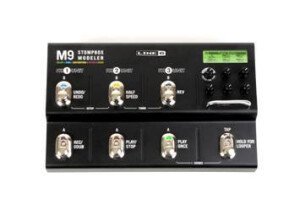
M9
Multi-Effects for Electric Guitar
-
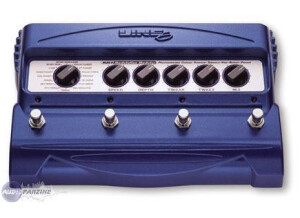
MM4
Multi-Effects for Electric Guitar
-
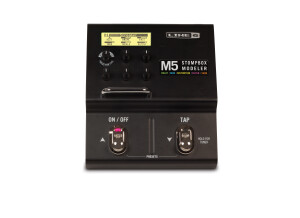
M5
Multi-Effects for Electric Guitar
$130 new (1 offer) -
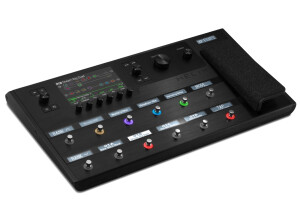
Helix
Multi-Effects for Electric Guitar
$210 new (2 offers) -
6/10
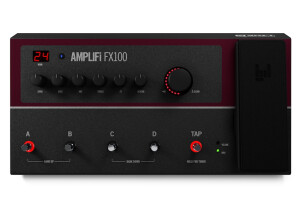
AMPLIFi FX100
Multi-Effects for Electric Guitar
-
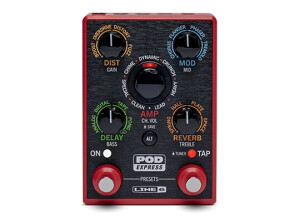
POD Express Guitar
Multi-Effects for Electric Guitar
$193 new (2 offers) -
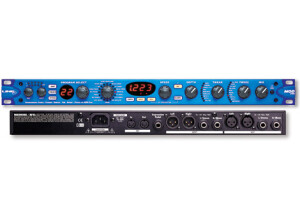
Mod Pro
Multi-Effects for Electric Guitar

